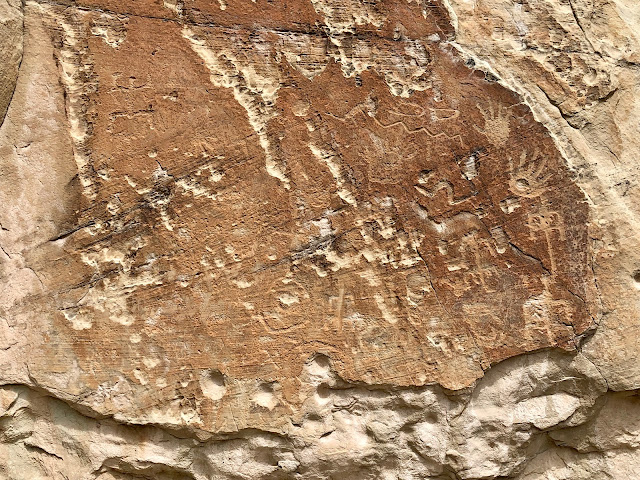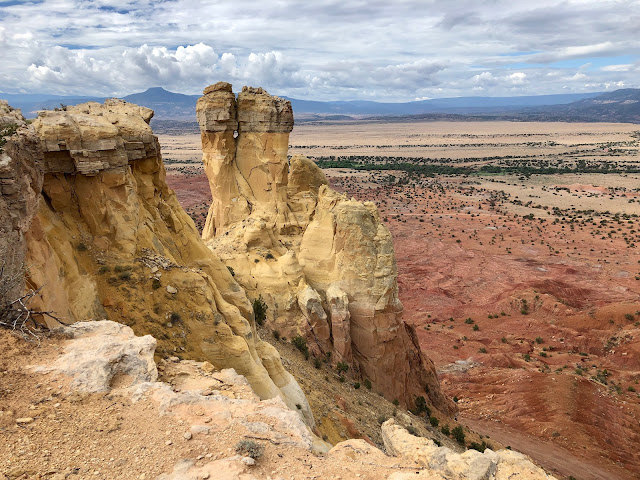Wednesday, July 29, 2020
Sunday, July 26, 2020
El Morro National Monument
We took a detour on our way back to Tucson from Abiquiu, to visit El Morro National Monument. “Located on an ancient east-west trail in north western New Mexico, the monument preserves a large pueblo built around 1275 AD, atop a sandstone promontory with a pool of water at its base. The large sandstone outcropping became a landmark, so that through several centuries, hundreds of petroglyphs were carved by ancestral Puebloans, and explorers and travelers left inscriptions carved into the walls.
The 875 room mesa top pueblo was home to about 1500 people, situated on the Zuni-Acoma Trail, an important prehistoric trade route. Spanish explorers visiting the area in the 16th century referred to the promontory as El Morro, and early Anglo-Americans called it Inscription Rock. With its oasis like source of water, El Morro was a stopping place for travelers in an arid, desolate region. The oldest historic inscription at El Morro, left by Juan de Onate, the first Spanish governor of the colony of Santa Fe de Nuevo Mexico, is dated April 16, 1605. Petroglyphs and carvings made by Ancestral Puebloans were inscribed centuries before Europeans arrived.
El Morro was designated a national monument by President Theodore Roosevelt in 1906, with US federal law prohibiting further carving on the cliffs from that year.” It is a special place.
The 875 room mesa top pueblo was home to about 1500 people, situated on the Zuni-Acoma Trail, an important prehistoric trade route. Spanish explorers visiting the area in the 16th century referred to the promontory as El Morro, and early Anglo-Americans called it Inscription Rock. With its oasis like source of water, El Morro was a stopping place for travelers in an arid, desolate region. The oldest historic inscription at El Morro, left by Juan de Onate, the first Spanish governor of the colony of Santa Fe de Nuevo Mexico, is dated April 16, 1605. Petroglyphs and carvings made by Ancestral Puebloans were inscribed centuries before Europeans arrived.
El Morro was designated a national monument by President Theodore Roosevelt in 1906, with US federal law prohibiting further carving on the cliffs from that year.” It is a special place.
Friday, July 24, 2020
Ghost Ranch
We stayed at Ghost Ranch for a week, the summer of 1981, and made wonderful memories. Today was our first time back, and Ghost Ranch still takes our breath away. I made a reservation to hike the Cathedral Rock Trail. Due to Covid restrictions, we were the only hikers on the trail. It was extraordinary!
After our hike, we toured the Ghost Ranch History Museum, and the Museum of Paleontology, with the Director of the Paleontology Museum giving us a private tour. Again, we were the only visitors, as they only allowed two people in the museum. Several dinosaurs have been found on Ghost Ranch, two now in the Museum of Natural History in New York City. Ancient Native Americans also lived on Ghost Ranch and there have been multiple finds, including 70 large pots fully intact. We had a good day!
After our hike, we toured the Ghost Ranch History Museum, and the Museum of Paleontology, with the Director of the Paleontology Museum giving us a private tour. Again, we were the only visitors, as they only allowed two people in the museum. Several dinosaurs have been found on Ghost Ranch, two now in the Museum of Natural History in New York City. Ancient Native Americans also lived on Ghost Ranch and there have been multiple finds, including 70 large pots fully intact. We had a good day!
Thursday, July 23, 2020
Tuesday, July 21, 2020
Circle Drive
After an early hike from our house this morning, Papa and I left at 10, to make a circle drive, south of Abiquiu, to visit Ojo Caliente Mineral Springs. https://ojocaliente.ojospa.com/ Used for thousands of years, Ojo Caliente is one of the oldest natural health resorts in the US, with the original hotel on the National Historic Register. They have added new facilities. We enjoyed looking around and we went on a 1.5 mile hike on the property, up to a mesa above the resort, to see P’osi Pueblo Ruins, dating to the 1300’s. The ruins of about 1000 Pueblo rooms are mostly melted back into the earth, but we’ve never seen so many pottery shards, laying all over the ground. You couldn’t take a step without seeing them.
We arrived at Rancho de Chimayo for a late lunch, after 1 p.m. Our food was delicious and we ate every morsel. The owner/chef has won multiple awards, including a James Beard award in 2014. The history of the ranch is very interesting. http://www.ranchodechimayo.com/history.
We drove back to our house, stopping at Sangre de Cristo Chapel, built in 1850, Holy Cross Catholic Church of Santa Cruz, built between 1733 and 1748, and the ruins of Santa Rosa de Lima, built in 1734. We had a good day!
Monday, July 20, 2020
Rainbows
The late afternoon storms that started four days ago, are yielding stunning rainbows. Last evening, we saw a double rainbow. It was stunning! We are really enjoying the incredibly nice weather in Abiquiu. We wake up to temps in the 50’s and are having highs in the 70’s to 80’s. We’ve been hiking every day, and most days we take a drive to explore the surrounding area. All good!
Sunday, July 19, 2020
Old Abiquiu
We woke up to a cool morning, at 55 degrees. We had a leisurely breakfast and then drove into Abiquiu, and up the hill into the old part of the village. The dirt plaza is fronted by Saint Thomas the Apostle Catholic Church, designed by Santa Fe architect, John Gaw Meem (he designed Los Poblanos in Albuquerque, where we stayed overnight a week ago), and built in 1935, on the site of the original church built in 1756 and burned in 1867. A large territorial home also fronts the plaza, along with a centuries old adobe ruin. Georgia O’Keeffe’s final home is around the corner, overlooking Rio Chama. We took another walk along Rio Chama, then drove along the dirt back road from Abiquiu to Abiquiu Lake. It was a fun morning!
Along the way, we’ve learned about Abiquiu and the Old Spanish Trail. From an historic placque in Abiquiu, “Settled in the 1700’s, Abiquiu was a remote village on the far northern frontier of Spanish America. The Abiquiu settlers were predominantly genizaros - people who by trade, enslavement, or capture had been taken from their Indian families and became part of the Hispanic culture. They were ideally suited to frontier life, exploration, and trade because they spoke several languages and knew the lay of the land.
Generations of Spanish explorers, priests, soldiers, and traders had not succeeded in establishing a trade and communication route between the distant Mexican provinces of California and New Mexico. It was not until well after Mexican Independence from Spain that Antonio Armijo first traveled the whole length of the trail from New Mexico to California.
Abiquiu was not a wealthy village, but in 1829, as trade between the United States and Mexico and within Mexico expanded rapidly, Antonio Armijo knew there was money to be made in opening trade with wealthy California ranchers and church missions. In late fall he led a caravan with 60 men, horses, and pack mules burdened with wool blankets gathered from the surrounding communities and headed to California. He returned the following April with 100 additional horses and mules. The Old Spanish Trail was born. Upon the return of Antonio Armijo, the governor of New Mexico immediately announced the success to his superiors in Mexico City. As a reward, the governor officially named Armijo “Commander for the Discovery of the Route to California.”
Along the way, we’ve learned about Abiquiu and the Old Spanish Trail. From an historic placque in Abiquiu, “Settled in the 1700’s, Abiquiu was a remote village on the far northern frontier of Spanish America. The Abiquiu settlers were predominantly genizaros - people who by trade, enslavement, or capture had been taken from their Indian families and became part of the Hispanic culture. They were ideally suited to frontier life, exploration, and trade because they spoke several languages and knew the lay of the land.
Generations of Spanish explorers, priests, soldiers, and traders had not succeeded in establishing a trade and communication route between the distant Mexican provinces of California and New Mexico. It was not until well after Mexican Independence from Spain that Antonio Armijo first traveled the whole length of the trail from New Mexico to California.
Abiquiu was not a wealthy village, but in 1829, as trade between the United States and Mexico and within Mexico expanded rapidly, Antonio Armijo knew there was money to be made in opening trade with wealthy California ranchers and church missions. In late fall he led a caravan with 60 men, horses, and pack mules burdened with wool blankets gathered from the surrounding communities and headed to California. He returned the following April with 100 additional horses and mules. The Old Spanish Trail was born. Upon the return of Antonio Armijo, the governor of New Mexico immediately announced the success to his superiors in Mexico City. As a reward, the governor officially named Armijo “Commander for the Discovery of the Route to California.”
Subscribe to:
Comments (Atom)





















































